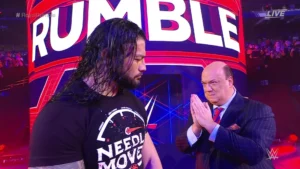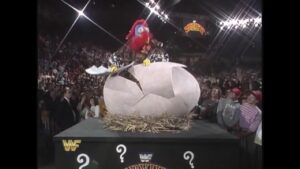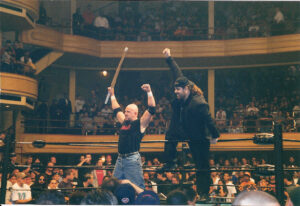Fickle?
You know as wrestling fans, we are fickle? Has anyone ever told you this? Wrestlers themselves? Other fans? Usually with a tone of ingratitude and a side of resentment. You don’t know what you got until it’s gone.
This isn’t to dispute that there is some truth within this idea. I agree we should “enjoy the ride” to some extent, as Will Gray said in his article “What’s Next for Cody Rhodes”. Fans can be fickle. We can always find things to complain about. Faults that should be fixed. It’s a constant on social media. But with top babyface champions, is it exclusively our fault?
To some degree, there is almost a historic self-fulfilling prophecy in this belief that once the fighting babyface completes his chase, and gets the championship, fans turn on them. There is precedent for this.
Shawn Michaels’ first run in 1996 felt regressive given HBK’s prior work as a heel. John Cena post WrestleMania 21 became comparable to Hulk Hogan regarding incivility. Kofi Kingston post KofiMania felt like a placeholder. Drew McIntyre during the Pandemic Era did what he could, but likewise became a generic babyface champion with a sword.
It’s not just a WWE problem. AEW experienced this issue with “Hangman” Adam Page. Not all of these runs resulted in the champions being booed, but some fans’ perceptions, enjoyment, and investment in these wrestlers’ characters were knocked.
For Cody Rhodes, this fear of the fans turning on him at some point could still be a reality.
Blame Game
When Dijak posted less than 24 hours after Wrestlemania XL the following, it was less prophetic and more capturing a mood/fear:
“It won’t be tomorrow, it won’t be next week, it won’t be next month, might not even be next year… but one day you guys are gonna turn so hard on Cody and boo his ass out of the building and when that day comes all I’m going to do is reference this post and tell you I was right.” Dijak, X.
Almost immediately, some fans rallied around this idea. Becoming defenders of Cody Rhodes and ready on social media to take any naysayers who criticized Cody to task. Yet news that post-Mania, Rhodes did not have any big set plans until SummerSlam created some unease. Perhaps a worry of repeating previous patterns.
Another wrestling cliché reveals more about this post-chase blues period than the dismissive “fans are fickle” brush-off. Considering it might reframe how it’s poor booking rather than us, the fanbase, that causes a disconnection from the top fighting babyface.
I don’t think we are the tail-wagging dog as many would like to claim. We as fans don’t control changes to the wrestling characters we invest in. Usually, the booking presents us with someone we can relate to. Yet sometimes, when they win the big one, it’s not us who changes first. It’s often them.
The Money is in the Chase
In those previous babyface champions I mentioned, a great deal of time, effort and most importantly characterization went into building these wrestlers into top stars fans could invest in. As fans, we were given a hook to grip us.
Underdog stories of achieving a childhood dream and or offering us, their supporters to vicariously live our dreams through them. Our heroes overcome the establishment, pigeon-holing, external barriers, or internal struggles like mental health. Experiences we can relate to. Things many of us struggle with in real life.
Like great movies or books, the protagonists of their stories went through a difficult, well-thought-out journey to face their big bad. The drama and tension were high. Adrenaline pumping. They win. But then…
Adrenaline… Dump
With films, once the story ends that’s it. Yet, when the story never ends in wrestling, things move to the next story.
But once you climb that highest mountain, the only logical way is down. Pessimistically, yes, but it doesn’t have to be.
There are various issues in the booking and presentation that have undermined the conquering hero. All of them, like an adrenaline dump, can leave a babyface champion reduced. Flushing out some of the elements that got fans behind them in the first place.
Character is Lost or Changes
When a fighting babyface’s champion’s character is primarily built around being an underdog, what’s left when they are now on top? If they remain the underdog, like Rey Mysterio during his WWE World Heavyweight Championship reign, the fluke or skin-of-your-teeth victories can undermine the reign. Making the champion look paper-thin rather than made of steel.
Similarly, if their character becomes the fighting babyface champion, like Kofi Kingston, the reign can feel formulaic. Defending the championship is a trope, not a personality trait. Without either tweaks, changes, or connective threads back to what got the fans invested in the first place, the babyface becomes a hollow shell.
In AEW, with “Hangman” Adam Page, the chase to become the AEW World Champion was strong. The character’s depiction of real-life issues of mental health (an analysis of you can find here), seemed to disappear once Page was champion.
The anxiety and mental struggle are not as prevalent. Despite some strong and fun championship defenses against Bryan Danielson, Lance Archer, and Adam Cole, the character lost connection with the audience.
Becoming a parody of a fighting babyface champion dented MJF’s World Championship reign, despite the turn being necessary in many regards (which you can read about here). Like Page and like other world champions elsewhere, the transition removed the aspects of MJF’s character that made fans fall in love with the character because…
You Changed
Some babyface characters once they win the big one suddenly shift towards a stereotypical character that completely changes their dynamic. The concept that being the world champion means you must act differently, “like a world champion”, becomes a corporate suit or like playing a role. The character becomes the representation of the company.
John Cena went from being from the streets and edgy and relatable to being a sanitized, kid-friendly brand whose comparisons to Hogan went beyond not losing clean. Cena became the establishment and WWE itself. Although still over with some, he appeared a “sellout” to others.
Future world champions like Drew McIntyre and Roman Reigns in part were pressed into a Vince McMahon-shaped mould. It’s the story development few want because it can feel like betrayal. Especially during the late 2000s and 2010s when the establishment was not serving the fans want we wanted.
Changing what works in any capacity, without adding any new layers or depth is creative strip-mining.
Weak/ Samey Follow-Up Stories
Post-chase, the follow-up story/stories can feel either placeholder, generic, or their designs obvious. Repetition of one of WWE’s most successful post-chase storylines is the most obvious.
After defeating Shawn Michaels, Steve Austin’s battle with his boss gave the Rattlesnake a multi-layered story arc that eclipsed his story arc. Set up before WrestleMania XIV, the story of the worker vs his employer resonated. It connected with the cultural zeitgeist. More importantly, it lent to Austin’s character’s strengths and appeal in a way that generated heat and drama.
Subsequent attempts failed beyond how obvious the ploy was. The stories leeched the wrestlers of character. The person who was supposed to represent us, the fans, becoming a puppet and mascot for the company felt like a betrayal. Fans rejected this because it was transparent.
Moved to Raw despite his rise taking place on Smackdown, John Cena’s first overarching feud was with the authority figure, Eric Bischoff. Represented in the ring for months by Chris Jericho and Kurt Angle, these opponents failed to get Cena over with some fans because of the stark differences in their abilities. It backfired and forced hardcore fans to associate Cena with Hogan.
When re-used with Roman Reigns to try and make him into the new John Cena years later, fans rejected this lazy and anarchic story device. Years under Vince McMahon’s creative where this story structure was replicated with a wrestling character who embodied the ideas of the establishment was obvious and disingenuous. Boring and old rope.
At the same time, other reigns struggled with a lack of overarching direction. Kofi Kingston’s reign involved a rotating cast of challengers of the month. Each offered little threat or no long-term reason for considering that Kofi might lose.
Artificial drama and stakes, or the lack of these, meant little drama.
Fickle for The Drama
Wrestling is part sport but part soap opera. Currently, for WWE, it’s clear to fans that if the storylines, like The Judgement Day saga with Liv Morgan, Dominic Mysterio, and Rhea Ripley keep hitting the spot, the flaws (as discussed here) are ignorable.
Beyond wrestling, we are invested in drama and tension. It’s what drives good stories. Remove that chase drama once the babyface is done, of course like metal to a magnet we are going to be drawn elsewhere.
Yes, a fighting champion can fight and defend the championship repeatedly. The issue with this is it gets old fast. It’s been done before. Likewise, diminishing returns become a historic issue for future champions. Paradoxically sometimes, the more a title is defended, the more predictable the outcome can be. Therefore, the less drama.
Where we get drama comes mainly from the actions of the heels. When looking at the hottest feud of the summer in WWE, Drew McIntyre vs. CM Punk (you can read my Match Point guide to the match here), both men have acted as justified heels. Heels can and do more interesting things than babyfaces.
Booking a smart babyface in the modern age is difficult. Heels have always had more room to color outside of the lines. More ways to win. They can go places the babyface can’t. Their stories become more interesting to follow. More dramatic.
When the babyface’s story is complete, it’s an eventuality that someone will beat them. Most likely a heel. It’s somewhat natural we move on to who might be next. It’s made easier when the booking of the babyface is lacking.
When the thrill has gone once the chase is done and the reasons to stick around past the peak aren’t compelling.
We’re fickle we follow the drama.
Breaking the Cycle- WWE
Both WWE and AEW have done a good job this year of ensuring that their fighting babyface champions have not fallen into these traps.
Have fans turned on Rhodes? Not really. Business metrics have been positive. Crowd responses have been strong. Responses to Rhodes’ promos and matches have been positive. Rhodes has retained much of his presentation. While Cody has had self-contained feuds with AJ Styles and Logan Paul in between the much larger narrative of The Bloodline, Cody has found a way to make things work.
A big part of this might be patience and trust in the process of “The Paul Levesque Era”. I’ve written elsewhere about how Triple H has fulfilled fans’ wishes (here). The fact that reports suggested there were no major plans for Rhodes until SummerSlam and the return of Roman Reigns sowed concerns.
However, WWE fans are being re-trained to expect longer title reigns and to expect big moments on the big four PPVs. Cody Rhodes retaining his aura, presentation and the qualities that fans have invested in has kept him as a strong champion.
The desire to see the Roman Reigns’ redemption story may at some stage eclipse Cody’s title reign, but that doesn’t mean Cody has failed or been failed. For the first time in years, WWE feels like a place where many top main event stars can represent the brand. Not just some singular chosen one.
Course Correction- AEW
Criticism aimed at AEW is pernicious and something I’ve analyzed both sides of here. Fan dissatisfaction at the presentation of Swerve Strickland as the world champion has been addressed. However, before his ascension, some changes in his character were made to avoid the mistakes of AEW’s past (as discussed here).
There were teething problems. Both real and bad faith that both champion and creative have addressed. The biggest is finding the balance between Swerve as a babyface and a heel, given his past actions. The fact that Heelish streak has not been ignored, plastered over like a plot hole, or dressed up has meant Swerve retains the aura and personality that resulted in his rise to the top.
Swerve in interviews, when on screen, in-ring, and on the microphone has become his champion rather than playing an expected role. One that a champion received as a babyface but who is justifiable and ruthless in mindset. Swerve defeating Will Ospreay silenced claims of Swerve as a transitional champion.
The prospect he beats and retires Bryan Danielson at All In are real. The fact fans are eager to see Swerve vs. Page IV with proper build shows how fans are invested in their stories.
We aren’t fickle as fans. We just want better.
More From LWOS Pro Wrestling
Header photo – WWE – Stay tuned to the Last Word on Pro Wrestling for more on this and other stories from around the world of wrestling, as they develop. You can always count on LWOPW to be on top of the major news in the wrestling world, as well as to provide you with analysis, previews, videos, interviews, and editorials on the wrestling world.






